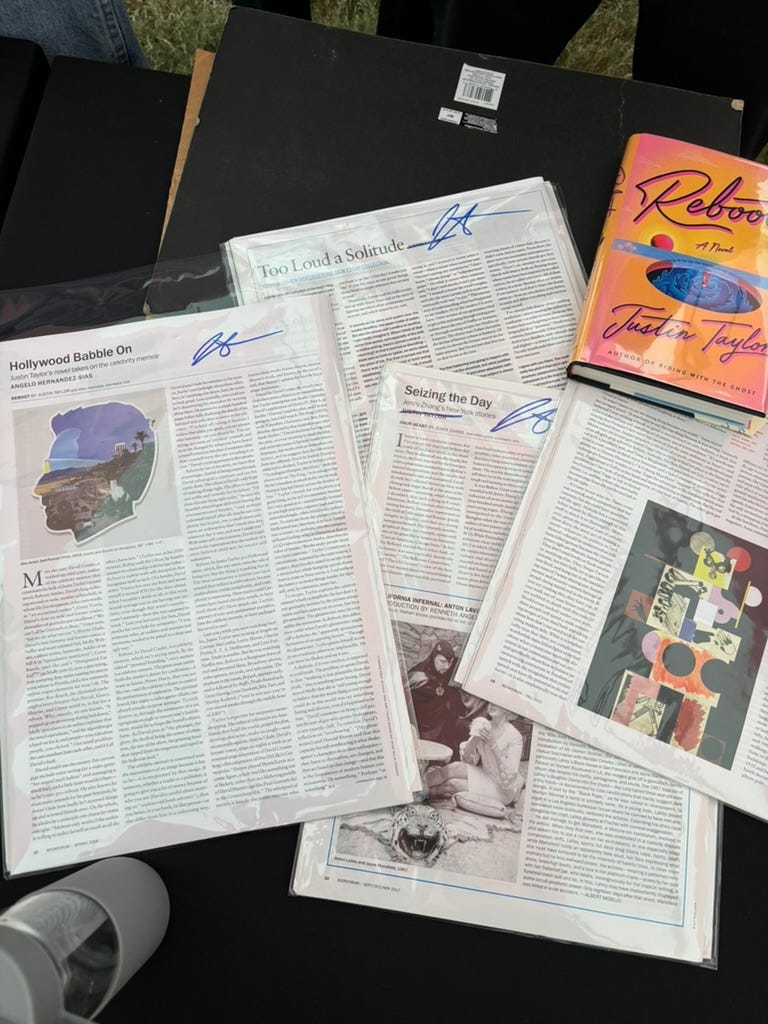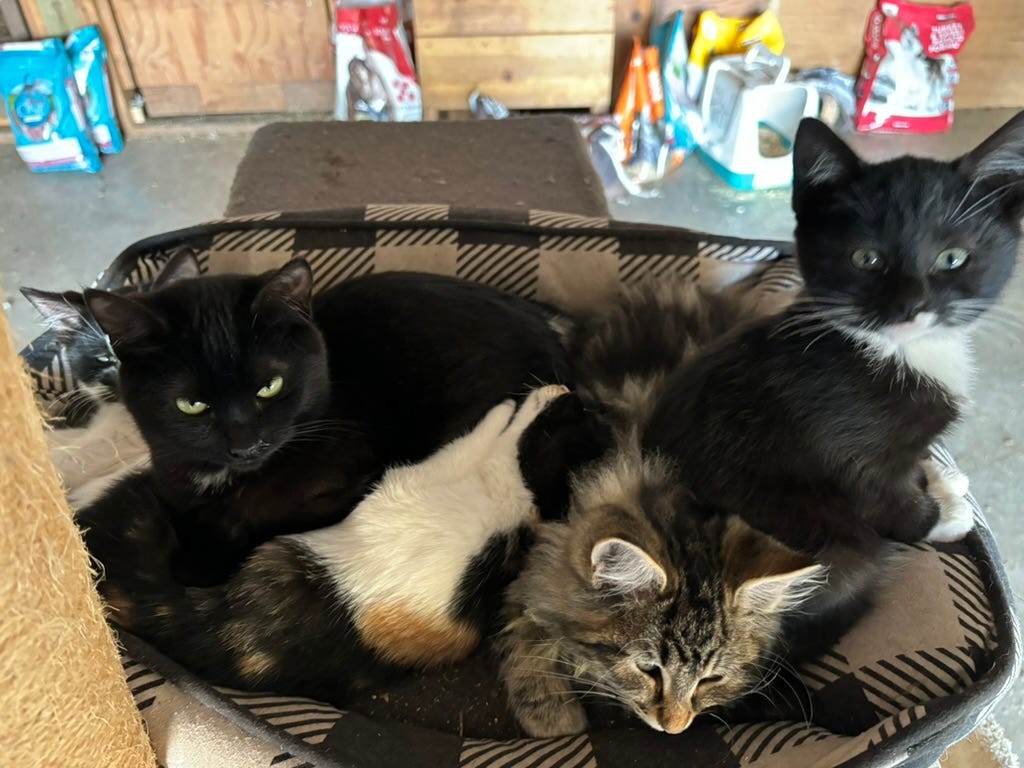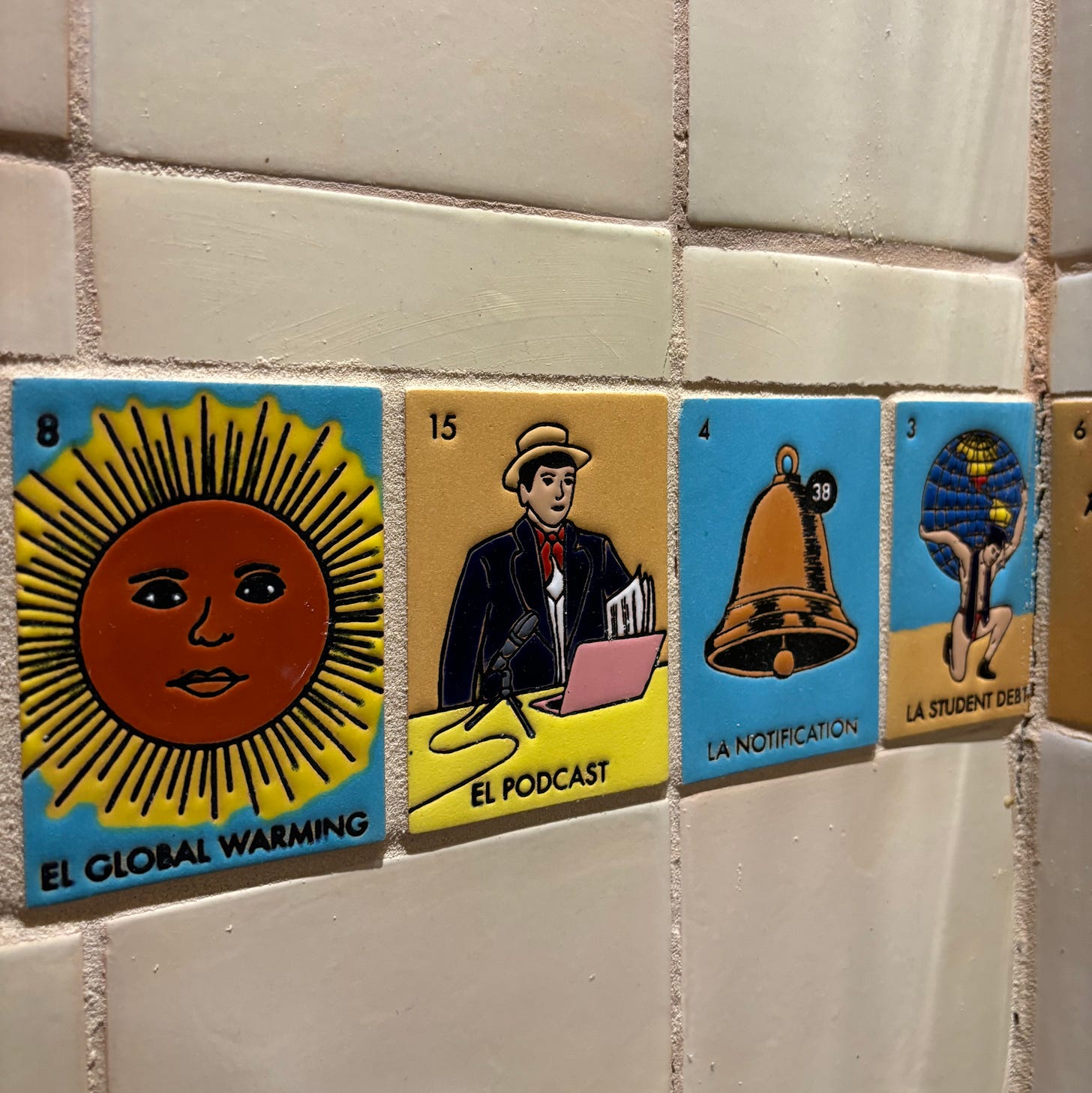Some good news: Reboot is a New York Times Notable Book of 2024. It has also been named a Best Book of 2024 by the Washington Post and Bookshop.org. I’ve taken it to book festivals in Brooklyn, Vegas, Nashville, Austin, and Miami. Brooklyn I told you about last time. Since then, I’ve been to the Museum of Neon and a karaoke bar in a double-wide, eaten tacos for breakfast and (not for breakfast) shrimp as thick as steaks. I was on some panels, signed some books, saw a lot of old friends and made some new ones. I finally published the big Dylan piece I’ve been working on all year. Also published a couple of new stories. Good bit of Bob in one of those as well. Caveat lector: after this I’m gonna lay off Dylan for a while. Really and truly, I promise. But I worked hard on these pieces & am proud of them and it’s not my fault they both came out in the same month, so please indulge me just this once more and then, hand to God, I’ll give him a rest.
“The Lines, They Are A-Changin'” appears in the fall issue of Bookforum. You can read it in full online, where, I’m happy to say, it has been the most-read piece on the site since the issue dropped. The piece is one part reported feature about the Bob Dylan Center in Tulsa, Oklahoma, one part omnibus review of the first books published based on work done in the Archive, and one part personal essay about my own deep dive into Bob’s back pages:
You know all that Walter Benjamin shit about the ineradicable irreproducible aura of the original? I wanted to OD on it. I wanted to see, like Hubble telescope photos of the births of galaxies, the ground zeroes where the letters had flowed from the point of the pen and bled into the grain of the paper and became the words that became the lines that became the songs.
The two new short stories are both print-only, at least for now. I hope you are able to get your hands on them. (If this turns out to be impossible, but you’re desperate to read them, email me.) In the meantime, I’ll share a bit about how and why each one got written.
“The Bridge After It’s Gone” appears in ZYZZYVA #128, the “Long Form” issue. It is 10,000 words long and was actually sold as a novella, though I think it may have been contextually demoted to “long story” since the issue’s other three pieces of fiction—by Bill Cheng, Lucy Corin, and Michael Jaime-Becerra—are all at least double its length.
The title of my story is adapted from a variant lyric in Dylan’s “You Ain’t Goin’ Nowhere”, one of my favorite songs of his, for reasons I can never quite find the words to explain. Other than these 10,000 words, that is. The song comes out of the Basement Tapes era, ie 1967. There’s a laconic surrealism complicating—sometimes ironizing, never wholly undermining—the roughhewn rootsiness of this material. A hedge against its slipping into folk piety. Dylan, of course, had already inherited, epitomized, and disowned that tradition by the time he was 25. Now he and the Band were going to, oops, invent Americana. And as it happens, the folk tradition is already rich in the laconic and surreal: “The Cuckoo”, “Three Nights Drunk”, “Swing and Turn Jubilee”, “Jenny Jenkins”, “Shady Grove”, just to name the first few that spring to mind.
This is the well from which “You Ain’t Goin’ Nowhere” is drawn. The same well that yielded up “Million Dollar Bash”, “Yea! Heavy and a Bottle of Bread”, “Lo and Behold!”, and all of those character-songs: “Quinn the Eskimo”, “Ruben Remus”, “Please Mrs. Henry”, etc. Throwback sounds and notions notwithstanding, there’s a distinctly modern sensibility at work here. The magic inheres in that paradox, if it is one, which it might not be, though paradox is a major motif of Dylan’s, especially here. Parallax, actually, is likely the better word. This is folk music for a world in which John Ashbery is already a decade into his career and the New Yorker is serializing Donald Barthelme’s Snow White in its entirety—ie 1967, as I said—now 57 years ago, and 57 years before that it was 1910, in November of which year Tolstoy died, and then in December—according to Virginia Woolf, anyway—human character changed.
My god but it’s been a long 20th century.
“You Ain’t Goin’ Nowhere” might be Dylan at his most Ashberian. The song is the household god of my long short story, though the story doesn’t take place in a house. It is set in the Catskills at a former sleep away camp-turned-event venue where a group of college friends have gathered for a wedding weekend. The present action occurs the night before the wedding but the narrative roves widely in time and point of view. It skips from character to character, tracking their perspectives on each other, their individual and collective pasts, presents, and futures. Relaxin’ and parallaxin’.
The first draft of this story was written in March 2020 during the first weeks of sheltering in place. It was 3600 words long, its governing chronal and perspectival logics already established. Also its plot architecture: it always began where it begins and always ended where it ends—the last line is right there in the first draft. (Brag.) Over the years, I folded in some realtime history of the pandemic era as we lived through it but mostly I focused on the characters: finding places to filigree details and expand moments, tease out echoes and correspondences, put more and more pressure on those governing logics, which are the twin engines driving a story that is in a lot of ways deliberately inert. Writing this story was like growing crystals for a geode that I’d already shattered.
I’ve been wanting to call something “The Bridge After It’s Gone” since 2006, when I was in a coffee shop on Avenue A, listening to some Dylan on a generation one iPod, leafing through Ashbery’s The Mooring of Starting Out and hoping (LOL) to get inspired to write a poem and I heard the lines, “We’ll climb that bridge after it’s gone / After we’re way past it” and wrote them down at the top of my blank notebook page to save for later. “You Ain’t Goin’ Nowhere”’s lyrics have never fully stabilized. The version that contains these lines is on Greatest Hits Vol 2, which came out in 1971; it had been a hit for the Byrds a few years earlier but Dylan had never released a recording of his own. (The first official version of the widely-bootlegged Basement Tapes would come out in 1975.) Some of this history is recounted in the story itself, by the character to whom the song is most meaningful, though she seems to be misremembering which version is on which release. She thinks of a pirated LP her father owned (likely 1969’s Great White Wonder, the album that, oops, invented the rock bootleg) on which the song does not appear, and wouldn’t contain this lyric even if it did, since he wrote it for the ‘71 recording.

The other new story, “What About This” appears in The Harvard Review #62 (Fall 2024). Another borrowed title: that of Frank Stanford’s Collected Poems. (Could go without saying but Bob has a walk-on in this one too.) I wrote this story two years ago almost to the day, at the end of a fall semester spent at Sewanee (where I usually only teach in summer) while living in a little university housing village populated mostly by seminary students. It was a great semester for teaching but a tough one for writing. A few days before I was due to pack up and go home I took my copy of Barry Hannah’s Long. Last. Happy: New & Collected Stories, to a coffee shop two towns over and sat there getting cranked up on espresso and his sentences for probably two hours until this came screaming out of me over the course of hour three. The story is narrated (wouldn’t you know it?) by an AWOL seminary student and I have no shame about confessing the Hannah pastiche. He has always been one of my big ones. Long. Last. Happy. was the first book I was ever asked to review for the New York Times. Hell, it’s my own name and quote on the cover of the paperback, which is the edition I had with me, and I’m not saying that to brag (much). I’m saying that I didn’t go to that coffee shop just to fly my key-kite in Hannah’s lightning storm and hope for a jolt, though that alone would have been reason enough. (Allan Gurganus once told me he keeps a copy of Airships on his desk for the same reason.) I was trying to face something down that I could sense but not see or name. The other day in Miami, on a panel we were on together, Garth Risk Hallberg quoted Jung to the effect that instead of fleeing the shadow you should turn and ask it what it wants. Was this that? Maybe not. But writing “What About This” broke a dry spell that badly needed breaking, and was grand fun besides.
A lot of great music has come out this year, a lot of it by artists I’ve been tracking for a long time and who I talk about pretty regularly on here. Some of it is fresh from the studio and some of it is fresh from the vaults. A few new discoveries as well.
“(I’m Gonna Get Over This) Some Day” - I saw T Bone Burnett at the Aladdin Theater in September. I was trying to get an interview and I didn’t. He has a powerful understated charisma that radiated from the stage. I liked The Other Side, his new album, OK at first but the songs opened up after hearing him play it live in its entirety. This is my favorite song from it. “Everything and Nothing” is not far behind.
“Can U Hear” may test you at first. It took me a while to get what Alan Sparhawk is doing with White Roses, My God, his first album since the death of his wife and Low co-founder Mimi Parker. I profiled Alan for The New Yorker back in April, and then Subpop ended up asking me to write the album bio for this record, so I spent a lot of time with it and have come to love it. Here’s a taste of what I wrote:
Trying to trace influences is a dodgy business, and fishing for comp titles is even worse. But let’s say you’re looking for forebears and fellow travelers to help situate WHITE ROSES, MY GOD. Just to start with a curveball, how about Childish Gambino, whose “Me and Your Mama”, Sparhawk has been known to cover live with The Derecho Rhythm Section, the funk quartet he plays in with his son? Or what about upstart weirdos extraordinaire 100 Gecs? Are those nods to fellow-Minnesotan Prince (maybe the Camille songs in particular?) in song titles like “Not the 1” and “Can U Hear”?
The new Allegra Krieger record, Art of the Unseen Infinity Machine, is a significant level-up for a young singer-songwriter already among the best of her cohort. In terms of vocals, lyrics, and overall vibe, “I’m So Happy I Cannot Face Tomorrow” may make that case most clearly. Ditto Haley Heyndrickx’s “Foxglove” from Seed of a Seed, her first new album in six years (well worth the wait), and “Don’t Mind Me” by the Styrofoam Winos, an eclectic trio who wear their considerable talents with a grin and shrug, though when I saw them play over the summer they all traded instruments between every song, apparently just to let us know they could. This is off their new record, Real Time, which I love. You might have heard these guys backing MJ Lenderman on the “Long Black Veil” cover that closes out his Live and Loose. Speaking of which: No Manning Fireworks on here: I like the album almost as much as the rest of you seem to, but at this point who still needs to be told?
This version of “Wedding Song”, from the Seattle Forum on February 9, 1974 is harrowing and uncanny. Dylan is singing one of the most heart-on-sleeve love songs he ever wrote in a voice that sounds like it is seething with white-hot rage. Like maybe he’s trying to murder love the way Macbeth murdered sleep. This is one of two songs I’ve included from the (LOL) 27-disc Tour ‘74 box set that is the main reason why I invested in a CD player a few months back.
Dylan sings every song like it’s a car he’s driving. Sometimes it’s an old beater he might park by the side of the road and sleep in. Sometimes it’s a minivan stuck in traffic while the kids squabble in the back. Sometimes it’s an ambulance with siren wailing on the wrong side of the road racing against the bleed-out of the guy on the gurney. Sometimes it’s a luxury sedan he’s thinking about leasing and sometimes it’s a sports car he just stole and, having done so, might stick to the speed limit for fear of drawing the heat or might do donuts in a Walmart parking lot at midnight because who fucking cares. You just never know, and the thing is, neither does he until he does it.
Forrest VanTuyl knows what I mean by that and that’s why I stuck him next to Bob. “The County” is a gorgeous, deceptively simple song that reveals more depth and complexity the more time you spend with it. The acoustic precision of the verses has a touch of Keats, though I bet if you asked Forrest he’d mention Robert Service’s “The Cremation of Sam McGee” before “To Autumn”—though he might well mention both. I first got to know Forrest as a player in his wife Margo Cilker’s band a few years ago. The last time Amanda and I saw them play, they did a couple of the songs he’s been writing for a record that I think is coming out sometime next year. I’ve heard it and it’s killer. We will fete it properly when occasion permits.
The Secret Sisters’ “Paperweight” is one of those bright-eyed, kinda-goofy-but-also-earnest love songs you can only get away with in country music. It risks mawkishness without succumbing to it, and its power derives not from the fact that it didn’t succumb, but from the fact that the risk was real. (Also true of “Wedding Song.”)
Nina Simone’s “Just Like Tom Thumb’s Blues” is one of about 150 songs you can listen to at the Bob Dylan Center on a jukebox curated by Elvis Costello. As mentioned in my piece, some saintly soul reproduced the juke for Spotify.
Justin Golden is a Piedmont bluesman out of Richmond, VA. His last album of originals came out in 2022 but two albums of folk and blues standards, Golden Country Vols 1 and 2, came out this year. I chose one song from each: “Midnight Special” and “Sitting On Top of the World.” Great songs with storied histories, which also means they’re pretty shopworn. He makes them new.
“gin tonic” - I had never heard of Dan Reeder until two months ago and now someone tells me something about him just about every other day. Seems good?
Aerial M was a Dave Pajo project from the ‘90s. Gorgeous slow-build instrumental postrock featuring a pre-Silver Jews Cassie Berman. Their Peel Session was released this year for the first time by Drag City. “Safeless” is from that session.
I said to my father-in-law the other day that Tom Petty might be the musician I like the most about whom I think the least. We were sitting in his truck in the Publix parking lot while the ladies were inside hunting up spinach and blue cheese, and some minor hit of Petty’s came on the Chris Stapleton channel on Sirius XM. Petty had been on my mind because I’d recently listened to the Life of the Record episode about the making of Long After Dark, recorded for the occasion of its deluxe reissue for whatever anniversary it is. Originally, I picked “Stories We Could Tell” off the bonus disc, then I went for “A Wasted Life”, since it’s such an odd downbeat song for Petty, and in its way a daring closer. But then I went with “Finding Out”, just to kick out the jams a little after all that gorgeous slow-build instrumental postrock.
“Traveling” is a gem of a Joni demo from the Hejira sessions. Also the title of Ann Powers’ recent biography of Mitchell. She reads the songs closely and puts a lot of herself into the story, making it an affable, non-redundant companion to David Yaffe’s more straightforward Reckless Daughter. I read Traveling while traveling, quickly and with much pleasure and admiration.
“When My Boy Walks Down the Street” — My friend Charley took me to see the Magnetic Fields play 69 Love Songs at Revolution Hall. They do it over two nights and we went to night one so we got the first 34, of which this is #26.
“Tears of Rage” - Jimi does Dylan but not the one you’re thinking of. I’d never heard this until very recently. It’s spare and relaxed and astonishing. I’ve been listening to it every day.
“Everything and Nothing” - T Bone redux, see above.
“Falling in Love with Somebody Better” strikes me as the most old-illuminati hotties-like song on the new illuminati hotties album. I don’t begrudge the growth and I dig the new record, but man I miss the batshit brattiness of the early stuff.
Billy Strings had a big year. Sang with Molly Tuttle and Post Malone, played two nights with Phish, had a baby, did Maron, is staying clean. He’s on a record that’s coming out next year with T Bone Burnett and Ringo Starr. “Seven Weeks in County”, from Highway Prayers, is like the VanTuyl and Secret Sisters songs in that it is a marvel of economy, precision, and vision that happens to also be rich in hard homespun wisdom come by honestly. And a singalong besides.
Speaking of singalongs, here’s “Maggie’s Farm” from a few nights after that “Wedding Song”, at another venue called the Forum, this one in Inglewood, CA on Valentine’s Day. This “Maggie” is more bop than blister. Rick Danko’s bass is going bonkers. They’re having a blast but also stoked that it’s the last night of tour. This is from disc 27, so I haven’t actually heard it on the CD player yet, because I’m listening in order and as of this writing am only up to disc 22.
“Sitting On Top of the World” - Justin Golden again. Fun fact: my short story “Gregory’s Year”, the last entry in my collection Flings, ends with a guy playing “Sitting On Top of the World” for his girlfriend. The last line in the book is the name of this song.










